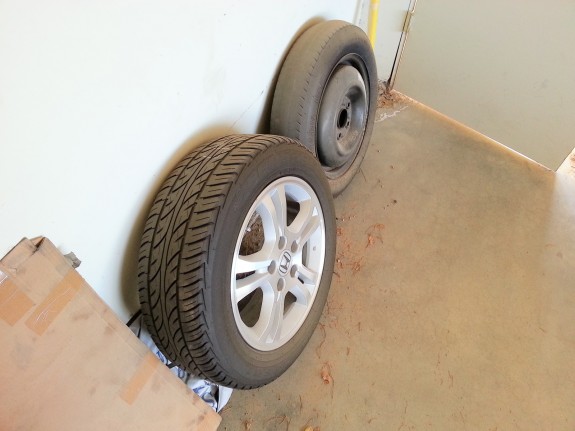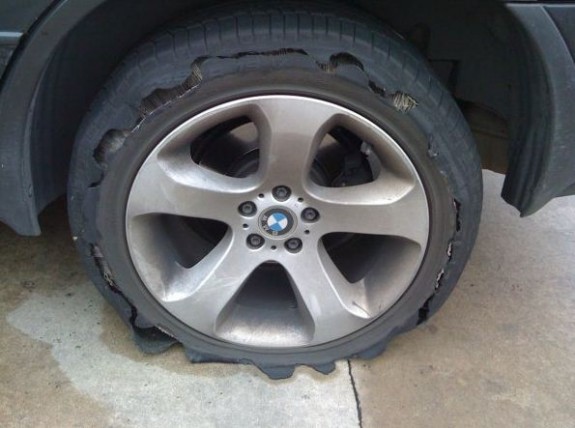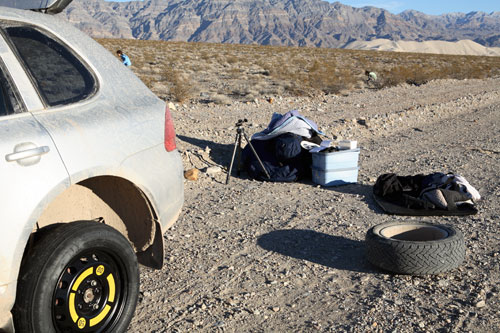Obscure Maintenance: Spare Tires

Donut spares, like this one from my Accord, aren't reliable over long distances or in adverse weather
Spare tires are such a critical item, especially during road trip season, that it’s a wonder nobody ever talks about them. Occasionally, a mechanic might ask you to replace a PCV valve, but I’ve never known even the best mechanic or car enthusiast to check the spare tire in a vehicle. If you care about getting to your final destination in one piece, regardless of what vehicle you drive, you should read and understand this article carefully.
Check the air pressure
Tires lose air slowly over time. That’s why avid car enthusiasts check their tire pressures regularly. That regular checking should include the spare tire. After all, it’s a tire made of rubber like all the others on the vehicle. The consequences of not doing so are dire. A coworker recently had a flat, only to find that her spare tire was flat as well, due to a bad valve stem. In my own encounters with a couple of bent rims, my full size spare tire was actually at 19PSI – well under the 32 recommended for my Accord.
Check the type and condition of the tire
Most people don’t know that there’s more than one type of spare tire, so it’s no surprise that they don’t know what type their spare is. Some manufacturers no longer even provide a spare tire, and don’t really do a good job of making owners aware of this little known fact (BMW/Toyota comes to mind). Sure, most companies compensate by either providing run-flat tires or a can of Fix-A-Flat, but that’s little comfort. Run-flat tires still become completely unusable if the sidewall fails, and Fix-A-Flat can’t fix that situation either.

This picture, from Asiarush of Bimmerfest forums, shows that Run-Flat tires like this aren't immune to becoming unusable.
Many manufacturers use small, donut spares to save space and money, especially on smaller vehicles. These donut spares are much smaller than a normal tire on the vehicle, and have issues. Think that you’re in the clear just because your donut spare is properly inflated? That donut is made for smooth sailing on dry roads. Add in rain, snow, or dirt roads, and you should be very scared. It’s even worse if you’re on a road trip – they’re made for short distances, at up to 55MPH. Use them too long, and they can go bald – which the last owner of my Accord apparently learned. If you’re traveling in deserted places or have a unique tire, consider carrying a full size spare. I always do in the Accord and in our Odyssey on family vacations – it’s absolutely worth the extra space and expense.
At least many pickup and SUV owners can say they have a full size spare, right? Sure, but that spare tire is usually mounted outside or under the vehicle. The release mechanism can get rusted or caked with dirt, and refuse to give you the spare. If the release mechanism is external, it generally also has a lock on it with a special key. If you bought a used vehicles, that lock might be sitting in the previous owners cabinet. Checking the spare regularly and thoroughly will prime you to deal with all these details, even with frazzled nerves in an emergency situation.
Even if you do manage to access the spare, it still might be a 10-15 year old tire that has been in the elements, like on my truck. Would you trust a 15 year old tire to carry a 7500lb truck? I wouldn’t – consider getting new tires a bit early and mounting one of the old tires on the spare wheel, if possible. Finally, if you travel off-road routinely, consider buying more spares, because sometimes when it rains, it pours – as this Cayenne owner found out when he got THREE flats coming out of Death Valley.

Having three flats in a place called Death Valley must be daunting. Luckily, only one was truly bad, while the other two were nursed along with an on-board air compressor.

